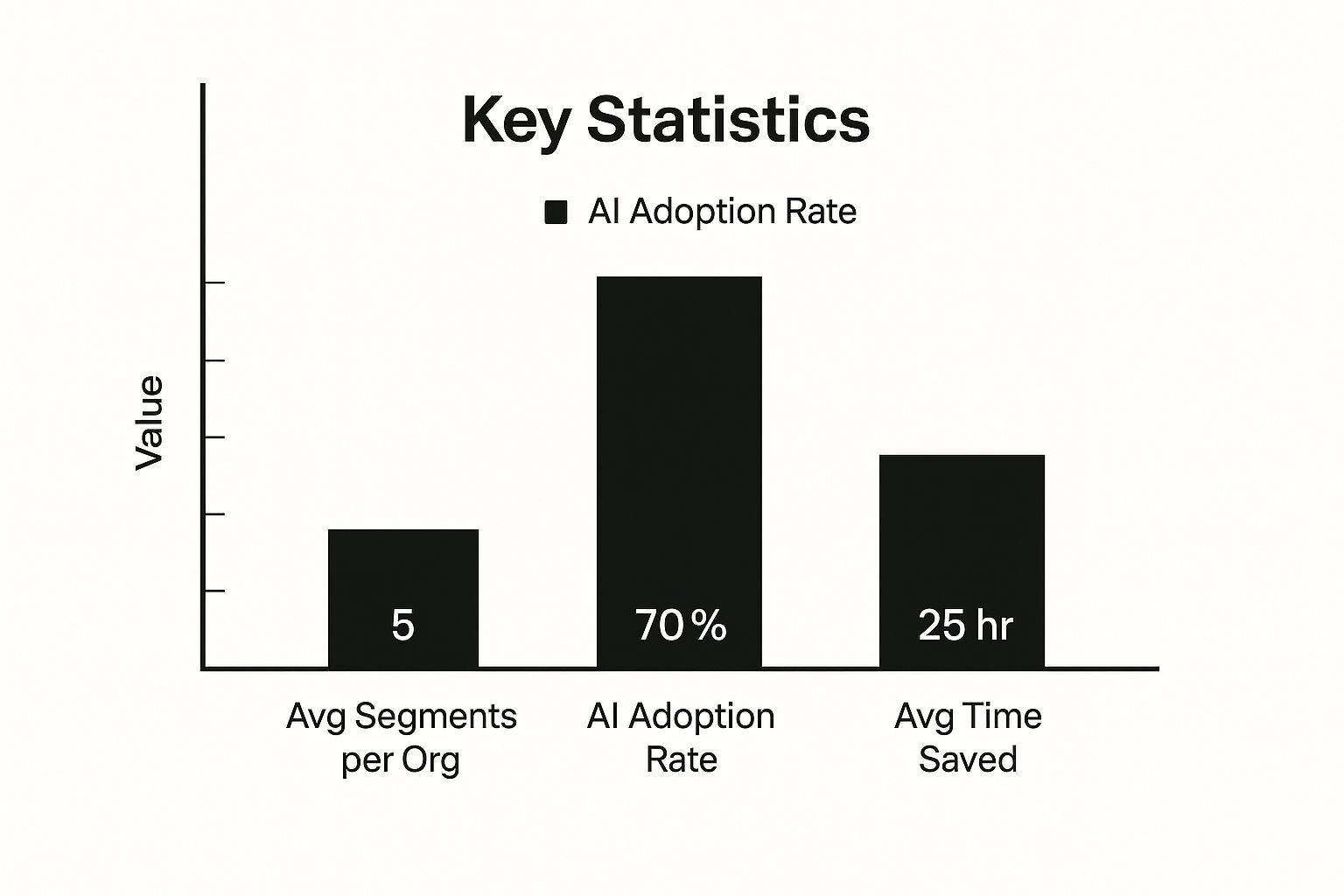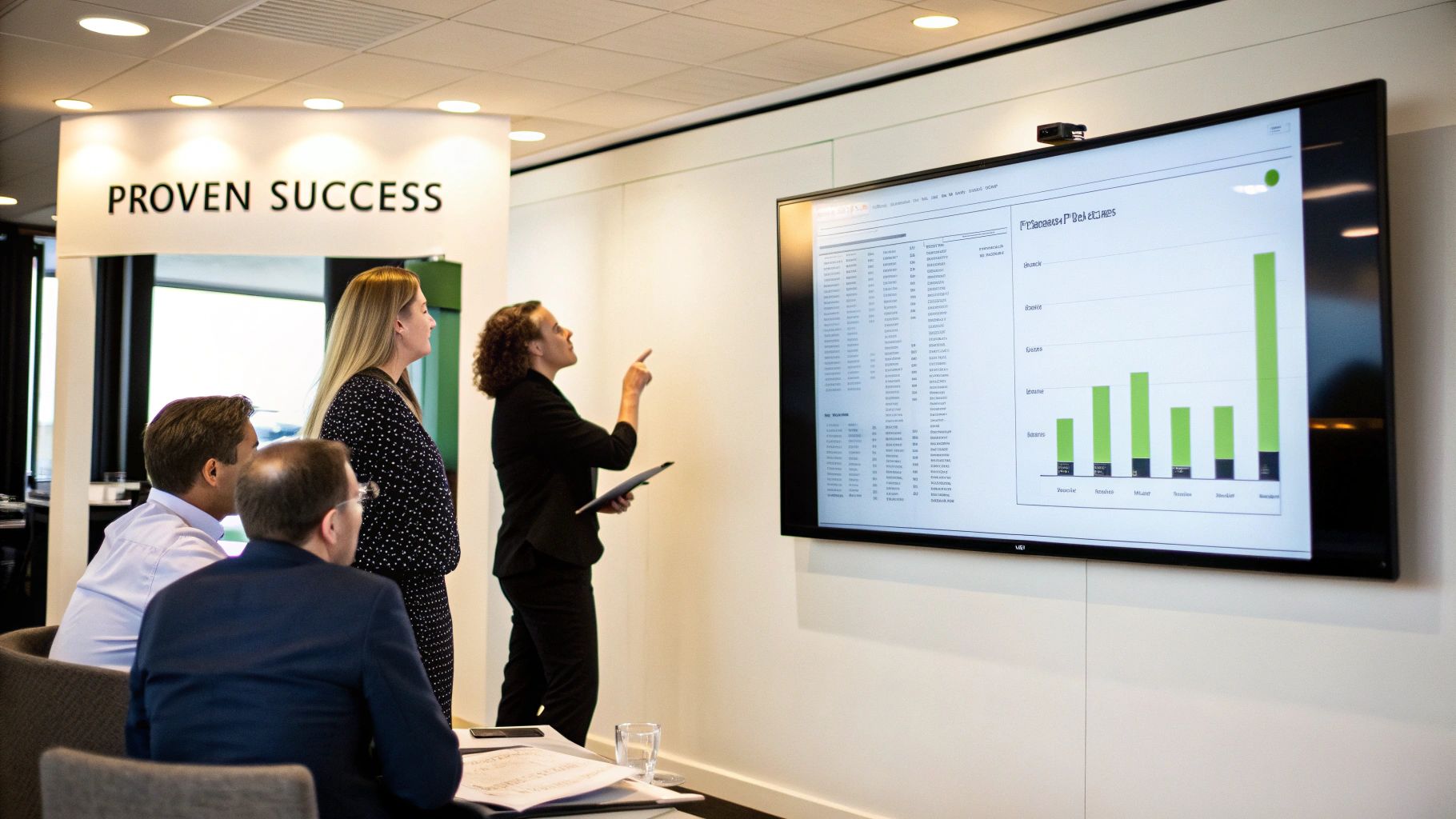Contents
- Workforce Segmentation Strategies for a Future-Ready Organization
- Beyond Demographics: The New Era of Workforce Segmentation
- Understanding the Multifaceted Approach
- The Impact of India’s Demographic Shift
- The Benefits of Precision Talent Strategies
- The Gen Z Factor: Rethinking Workforce Segmentation
- Understanding the Gen Z Difference
- Engaging Gen Z Talent
- Bridging the Generational Gap
- Segmentation That Drives Meaningful Engagement
- Identifying Unique Engagement Drivers
- Designing Segment-Specific Initiatives
- Measuring and Maintaining Engagement
- Skills-Based Segmentation: The Competitive Advantage
- Mapping Existing Skills and Identifying Gaps
- Leveraging Analytics for Personalized Development
- Implementing Skills-Based Segmentation
- Building a Future-Ready Workforce
- Segmentation Strategies for Hybrid Work
- Tailoring Strategies for the Hybrid Workforce
- Maintaining Cohesion and Equity
- Optimizing Organizational Structure
- Your Workforce Segmentation Implementation Blueprint
- Step-by-Step Implementation
- Addressing Implementation Challenges
- Technology Solutions for Workforce Segmentation
- Measuring the Effectiveness of Your Segmentation
- Ready to Transform Your Workforce Strategy?
Workforce Segmentation
Workforce Segmentation Strategies for a Future-Ready Organization
Beyond Demographics: The New Era of Workforce Segmentation
Workforce segmentation is no longer simply about categorizing employees by age, gender, or location. Modern organizations are looking beyond these basic demographics to develop more nuanced and effective talent management strategies. This new era incorporates a multifaceted approach, considering factors like skills, work preferences, engagement styles, and career aspirations. This allows companies to move away from generic, one-size-fits-all solutions and toward personalized initiatives that truly connect with specific employee groups. This shift is driven by the need to maximize productivity and customize development programs for a diverse workforce.
Understanding the Multifaceted Approach
For example, consider a company with employees from multiple generations. While demographic data provides a general overview, it doesn’t capture the unique needs and motivations of each generational group. Gen Z employees might prioritize learning opportunities and flexible work arrangements, while Baby Boomers might value job security and recognition for their experience. This means a single engagement strategy won’t effectively connect with everyone. Workforce segmentation allows organizations to create tailored initiatives that address the specific needs of each group, ultimately boosting overall engagement and retention.
Additionally, understanding the diverse skill sets within an organization through workforce segmentation allows for the creation of targeted training programs. This ensures that development opportunities are aligned with both individual career goals and the company’s overall strategic objectives.
The Impact of India’s Demographic Shift
India’s demographic trends have significant implications for workforce segmentation strategies within the region. The country’s population dynamics require a sophisticated approach to talent management. As of 2024, India became the world’s most populous nation, comprising 18% of the global population. The dominant working-age population is a key asset, but the youth segment (15-24 years) is projected to decrease by 15% between 2024 and 2050.
The prime working-age group (15-49 years) will peak in 2035 and then decline slightly. Find more detailed statistics here This cohort size variation necessitates segmenting the workforce to optimize productivity and labor force participation. This highlights the importance of segmenting the workforce not only by skills or roles but also by age and generational needs to adapt to these shifts. Different age segments will require tailored employment policies, training, and reskilling programs to accommodate the changing dynamics of the labor supply and sustain economic growth.
The Benefits of Precision Talent Strategies
By implementing precise talent strategies based on robust workforce segmentation, companies can see several tangible benefits. Tailored development programs can lead to improved employee skills and performance, ultimately contributing to increased productivity. Furthermore, by understanding the drivers of engagement for different employee segments, organizations can create targeted initiatives that boost morale and reduce turnover.
This focus on specific needs fosters a more inclusive and motivating work environment, leading to greater employee satisfaction and retention. Ultimately, effective workforce segmentation empowers companies to unlock the full potential of their workforce and achieve their business objectives.
The Gen Z Factor: Rethinking Workforce Segmentation

As India’s demographic landscape changes, so must approaches to workforce segmentation. This is especially true with the growing influence of Gen Z, the first truly digital native generation impacting workplaces worldwide. They possess a unique blend of tech skills, expectations, and preferences that demand a new approach to talent management.
Understanding the Gen Z Difference
Growing up in a hyper-connected world has shaped Gen Z’s communication styles. They often favor instant messaging and social media platforms like Instagram over traditional email. Their career expectations also diverge from previous generations, emphasizing continuous learning and development. They seek purpose-driven work and employers whose values align with their own.
Gen Z prioritizes work-life integration, blurring the lines between professional and personal spheres. This requires flexible work arrangements and a genuine focus on employee well-being.
The rapid rise of Gen Z in India is significantly influencing workforce segmentation. By 2025, they are projected to represent 27% of the Indian workforce. This marks a considerable shift in the labor market. Gen Z brings new perspectives, inherent digital fluency, and different work priorities compared to older generations. Indian employers must adapt their hiring and management strategies to meet these preferences. Explore this topic further
Engaging Gen Z Talent
Engaging Gen Z effectively requires organizations to rethink traditional engagement strategies. Mentorship programs connecting Gen Z employees with experienced professionals from other generations can be highly effective. Offering flexible work arrangements and opportunities for skill development are also crucial for attracting and retaining this talent pool.
Providing access to online learning platforms like Coursera and encouraging participation in industry conferences demonstrates a commitment to professional growth. This benefits not only Gen Z employees but also fosters a more dynamic and adaptable workforce as a whole.
Bridging the Generational Gap
While focusing on Gen Z is crucial, maintaining organizational cohesion across all generations is equally vital. Workforce segmentation must consider the needs of all employees, ensuring that tailored strategies don’t unintentionally alienate other segments.
Finding common ground and fostering intergenerational collaboration is key. Creating cross-generational teams that leverage each group’s strengths and implementing communication strategies that cater to diverse preferences are good starting points. A successful workforce segmentation strategy empowers all employees to contribute their unique talents and thrive in a multi-generational work environment, ultimately strengthening the organization and driving its success.
Segmentation That Drives Meaningful Engagement

Employee satisfaction surveys don’t paint the full picture. Truly engaging your workforce requires understanding what motivates individuals. This means digging deeper than surface-level observations and identifying specific drivers that resonate with different segments of your team. This focused approach directly impacts your key performance indicators (KPIs).
Identifying Unique Engagement Drivers
Top-performing organizations understand a one-size-fits-all approach to employee motivation simply doesn’t work. Younger employees might prioritize skill development and career advancement, while experienced team members value work-life balance and recognition. This is where workforce segmentation comes in. By understanding these unique drivers, businesses can develop targeted programs with a measurable impact. For a deeper dive into talent attraction and hiring, check out this article: How GICs in India can attract and hire the best talent.
Workforce engagement in India saw a significant drop, decreasing from 24% in 2024 to 19% in 2025, according to the ADP Research “People at Work 2025” report. This five-percentage-point decline represents the largest global decrease. It highlights the challenges facing the Indian workforce, particularly younger employees. Experts suggest focusing on flexibility, strong interpersonal connections, and tailored skill development to help reverse this trend. Read the full research here
Designing Segment-Specific Initiatives
Understanding your workforce segments allows you to design targeted engagement initiatives. These programs resonate better with individual groups and produce better results than generic approaches. However, aligning individual initiatives with broader company goals is critical for overall success. Careful planning and execution ensure individual needs are met while supporting the organization’s objectives.
The following table provides a snapshot of how engagement drivers can differ across workforce segments, along with recommended engagement strategies:
Engagement Drivers Across Workforce Segments
This table reveals the striking differences in primary engagement drivers across distinct workforce segments, highlighting how motivational factors vary significantly by generation, career stage, and job function.
| Workforce Segment | Primary Engagement Drivers | Secondary Drivers | Recommended Engagement Strategies |
|---|---|---|---|
| Younger Employees (Gen Z, Millennials) | Career Development, Skill-Building, Mentorship, Purpose-Driven Work | Work-Life Integration, Flexibility, Recognition | Offer training programs, mentorship opportunities, involve them in projects aligned with company values, promote flexible work arrangements |
| Experienced Employees (Gen X, Boomers) | Work-Life Balance, Recognition for Contributions, Leadership Opportunities, Job Security | Professional Development, Competitive Compensation, Meaningful Work | Provide opportunities for leadership roles, recognize their expertise, offer flexible work options, prioritize job security and stability |
| Technical Roles (Engineering, IT) | Challenging Projects, Opportunities to Learn New Technologies, Collaboration with Peers, Professional Development | Competitive Compensation, Recognition for Technical Expertise, Career Growth | Offer challenging projects, provide access to new technologies and training, foster a collaborative work environment, offer clear career paths |
| Sales/Marketing Roles | Performance-Based Incentives, Recognition for Achievements, Opportunities for Advancement, Clear Goals and Expectations | Professional Development, Team Collaboration, Work-Life Integration | Implement performance-based bonuses and rewards, publicly acknowledge achievements, provide opportunities for promotion, set clear and attainable goals |
This table demonstrates how tailoring engagement strategies to specific workforce segments is key to maximizing motivation and productivity. By addressing the unique needs and priorities of each group, organizations can create a more engaged and fulfilling work environment.
Measuring and Maintaining Engagement
Measuring engagement across segments is essential for tracking progress and spotting potential problems. This means going beyond simple surveys and using data-driven methods. Recognizing early warning signs of disengagement is key to implementing corrective actions before they impact performance. This proactive approach helps maintain a motivated and productive workforce. Leading companies also focus on inclusive cultures that value diverse perspectives. This means building an environment where everyone feels respected while maintaining a strong, unified organizational identity. This balance is vital for a thriving workforce.
Skills-Based Segmentation: The Competitive Advantage
In today’s rapidly evolving business landscape, skills-based workforce segmentation provides a distinct competitive edge. Instead of clinging to traditional, role-based organizational charts, progressive companies are embracing agility and capability-focused teams. This entails carefully mapping the skills within the organization, identifying crucial skill gaps, and developing tailored training programs for different talent segments.
Mapping Existing Skills and Identifying Gaps
Understanding your organization’s current skill set is the first step in skills-based segmentation. Several methods can be employed, such as self-assessment surveys, skills assessments, and performance reviews. With a clear picture of existing capabilities, you can pinpoint critical gaps that must be addressed to achieve future business goals. This focus ensures development efforts are directed where they’re needed most.
For instance, if your company is moving towards greater automation, identifying employees with existing coding or data analysis skills, or those with the aptitude to learn them, becomes vital. This targeted approach allows for efficient training resource allocation and faster adaptation to shifting market needs. Ultimately, your organization can proactively cultivate the skills needed to stay competitive. More information can be found in the India Skills Reports.
Leveraging Analytics for Personalized Development
Leading companies are utilizing advanced analytics to evaluate skills at scale. This enables the creation of personalized development paths for different skill segments within the workforce. This individualized strategy acknowledges that employees have diverse learning styles and career goals. By tailoring development programs to individual needs, organizations maximize the impact of their upskilling investments.
Furthermore, analytics can help quantify the impact of these upskilling initiatives, demonstrating the return on investment (ROI) of workforce development. This data-driven approach provides valuable insights into program effectiveness and supports continued investment in employee growth.
Implementing Skills-Based Segmentation
Putting skills-based segmentation into action involves developing practical frameworks. These frameworks should enhance workforce agility, internal mobility, and resilience to change. One approach is to create internal talent marketplaces where employees can find opportunities to apply their skills in different projects or roles within the organization.
This enhanced internal mobility not only benefits individual employees with new development opportunities but also strengthens the organization overall. By quickly redeploying talent to meet emerging business needs, companies can adapt faster to disruptions and maintain a competitive edge.
Building a Future-Ready Workforce
Skills-based workforce segmentation is all about building a future-ready workforce. By prioritizing skills over traditional roles, organizations can create a more dynamic and adaptable talent pool. This enables companies to effectively respond to evolving market demands and technological advancements.
This emphasis on future skills is especially important in the IN region, where the job market is transforming rapidly. By investing in the development of in-demand skills, organizations ensure their workforce is equipped for the jobs of tomorrow. This proactive approach to talent management is essential for sustained success in today’s competitive environment.
Segmentation Strategies for Hybrid Work
The hybrid work model has changed how we approach workforce segmentation. Factors like location preference, work style, and tech savviness are now key to categorizing employees. This calls for fresh perspectives on management, communication, and performance reviews.
Tailoring Strategies for the Hybrid Workforce
Managing a hybrid workforce successfully means understanding the unique needs of different employee groups. For instance, fully remote workers may need different communication methods than those in the office regularly. This might involve using tools like Slack for quick updates or having regular virtual check-ins. You might be interested in: OYO’s hiring plans.
Performance reviews also need adjustments to reflect different work environments and challenges. This could mean focusing on project results instead of just hours worked. This ensures fair performance assessment in a hybrid setting.

This infographic shows key data on workforce segmentation, including average segments per organization, AI adoption rate, and time saved.
The data reveals a growing trend of workforce segmentation, with an average of 5 segments per organization. The high AI adoption rate of 70% and average time saving of 25 hours highlight the efficiency gains.
Maintaining Cohesion and Equity
A strong company culture in a hybrid setup requires deliberate effort. Regular team-building activities, both virtual and in-person, can help connect different work segments. These could include online games and virtual coffee breaks, or team lunches and offsite events.
Fair treatment is essential. All employees, regardless of their work location, should have equal access to development and advancement opportunities. This could mean offering online training accessible to all or including remote workers in key decisions.
Optimizing Organizational Structure
Data-driven decisions are key to optimizing your organizational structure for hybrid work. Analyzing performance and engagement across different segments provides valuable insights. This helps determine which roles thrive in various work arrangements and how to adjust teams.
The following table provides an overview of how different workforce segments perform under different work arrangements:
Work Arrangement Effectiveness by Workforce Segment
This table shows performance metrics across different workforce segments under various work arrangements, comparing productivity, engagement, and retention statistics for fully remote, hybrid, and on-site employees.
| Workforce Segment | Fully Remote Performance | Hybrid Performance | On-Site Performance | Optimal Work Arrangement |
|---|---|---|---|---|
| Software Engineers | High Productivity, Moderate Engagement, High Retention | High Productivity, High Engagement, High Retention | Moderate Productivity, Moderate Engagement, Moderate Retention | Hybrid/Fully Remote |
| Sales Representatives | Moderate Productivity, High Engagement, Moderate Retention | High Productivity, High Engagement, High Retention | Moderate Productivity, Moderate Engagement, Low Retention | Hybrid |
| Marketing Specialists | High Productivity, High Engagement, High Retention | High Productivity, Moderate Engagement, Moderate Retention | Moderate Productivity, Low Engagement, Low Retention | Fully Remote/Hybrid |
| Customer Service Representatives | Moderate Productivity, Moderate Engagement, Moderate Retention | Moderate Productivity, High Engagement, High Retention | High Productivity, High Engagement, Moderate Retention | On-Site/Hybrid |
| Operations Staff | Low Productivity, Low Engagement, Low Retention | Moderate Productivity, Moderate Engagement, Moderate Retention | High Productivity, High Engagement, High Retention | On-Site |
Key insights from the table highlight the variability in optimal work arrangements based on the workforce segment. For instance, software engineers often thrive in remote or hybrid settings, while operations staff generally perform best on-site.
Some roles may be better suited for fully remote work, while others benefit from a hybrid model. Using data to guide these decisions creates a more effective and flexible structure, adapting to the changing needs of the workforce.
Your Workforce Segmentation Implementation Blueprint

Putting workforce segmentation into practice requires a well-defined plan. This section offers a practical blueprint for implementation, going beyond simple demographics. It incorporates behavioral patterns, performance data, career aspirations, and engagement indicators. This in-depth analysis provides valuable insights into your talent pool.
Step-by-Step Implementation
Successfully implementing workforce segmentation involves a structured, phased approach:
- Define Your Objectives: What are you hoping to achieve? Is it improved engagement, better retention, or increased productivity? Clearly defined goals are essential for guiding your segmentation strategy.
- Identify Key Segmentation Criteria: Determine the most relevant factors for your objectives. These could include skills, job roles, location, performance metrics, or engagement levels. For instance, if talent development is your focus, skills-based segmentation might be most effective.
- Gather Data: Collect comprehensive data from various sources like employee surveys, performance reviews, HRIS Systems and internal communication platforms. This data forms the foundation of your segmentation analysis. Quick feedback mechanisms like pulse surveys within emails can be particularly useful, as suggested by ContactMonkey.
- Analyze and Segment: Employ data analysis tools to identify patterns and group employees with shared characteristics. This analysis will reveal distinct segments within your workforce.
- Develop Targeted Strategies: Design specific strategies for each segment, aligned with your overall business objectives. This could involve creating different training programs for varying skill levels or personalizing communication strategies. The ContactMonkey case study demonstrates this by using real-time email analytics to optimize messaging.
- Implement and Monitor: Put your strategies into action and track their effectiveness. This allows you to identify what’s working and make adjustments as needed. Regularly review and refine your model as workforce dynamics change.
Addressing Implementation Challenges
Workforce segmentation presents specific challenges:
- Data Privacy: Ensure compliance with all relevant privacy regulations in your data collection and analysis. Transparency with employees about data usage is vital.
- Avoiding Stereotypes: Recognize meaningful differences while avoiding harmful stereotypes. Use data responsibly to create inclusive segments that reflect your workforce’s diversity.
- Maintaining Inclusivity: Prioritize a fair and equitable environment for all employees, regardless of segment. Ensure equal access to opportunities across the board.
Technology Solutions for Workforce Segmentation
Several technology solutions can support sophisticated segmentation approaches:
- Predictive Analytics Platforms: These tools use historical data to forecast future trends, helping you anticipate workforce needs and address skill gaps.
- Employee Listening Tools: Platforms like ContactMonkey gather real-time sentiment data through email analytics, surveys, and feedback mechanisms, offering valuable insights into employee engagement.
- HRIS Systems: A robust HRIS system acts as a central hub for employee data, facilitating the tracking of key metrics and measuring the impact of your strategies.
Measuring the Effectiveness of Your Segmentation
Track specific metrics to understand how well your segmentation is working:
- Employee Engagement Scores: Monitor segment-specific engagement levels to see the impact of your tailored strategies.
- Retention Rates: Track retention within each segment to evaluate your retention programs.
- Performance Metrics: Analyze segment-specific performance data to see how initiatives are improving productivity.
Analyzing these metrics enables continuous improvement and ensures alignment with your business goals. Ongoing refinement is crucial for adapting to the dynamic nature of today’s workforce.
Ready to Transform Your Workforce Strategy?
Taggd offers expert Recruitment Process Outsourcing (RPO) services. We help optimize talent acquisition and management processes through strategic workforce segmentation. Visit Taggd.in to learn more about achieving your talent goals.
